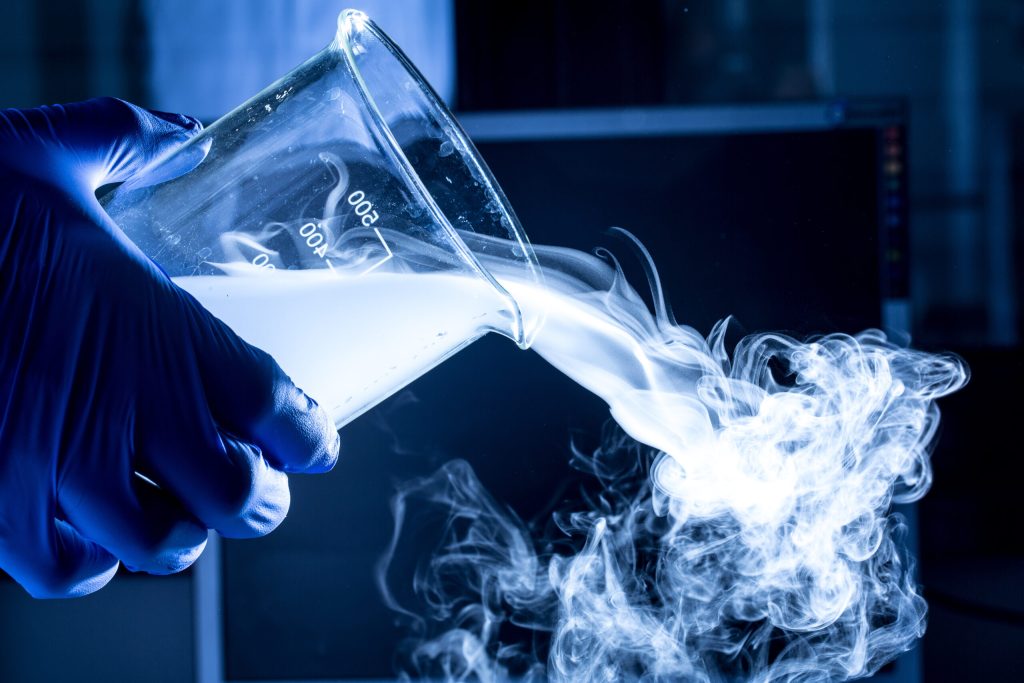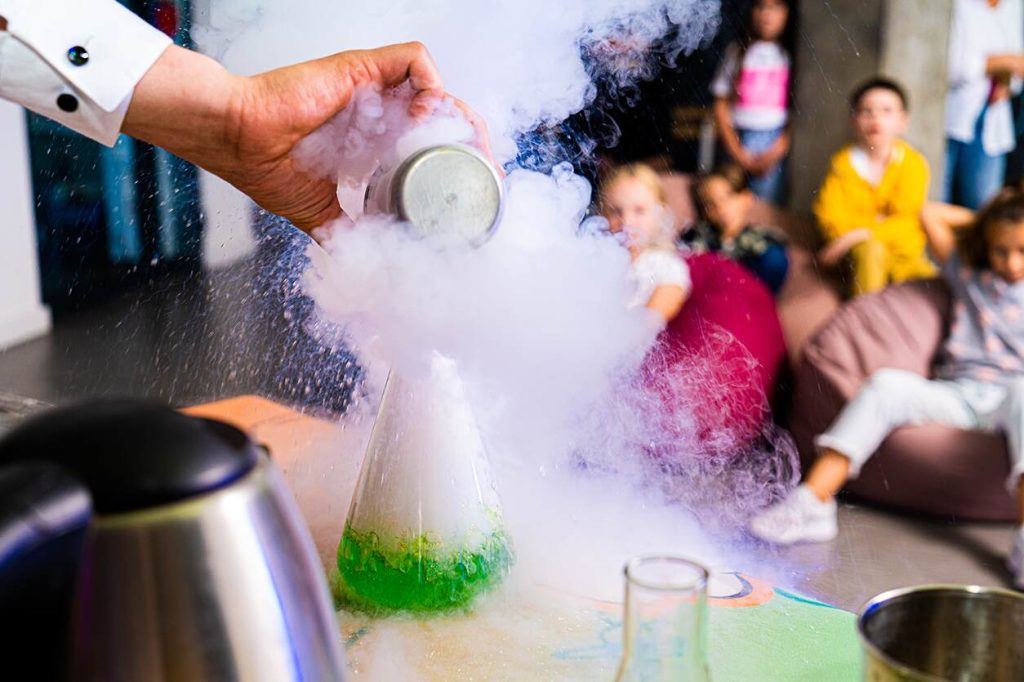
Liquid nitrogen is one of those substances that seems almost magical when you first encounter it. You’ve probably seen it in viral science videos where someone dips a flower into it, only to shatter it like glass a moment later. Or maybe you’ve watched chefs use it to create dramatic clouds of vapour around fancy desserts. But as fascinating as it looks, liquid nitrogen is not something you’d want to casually touch. The real question is: what would actually happen if you did?
The answer depends on how long you make contact, how much of your skin touches it, and whether you understand the strange physics at play. Let’s break it down in a way that’s both scientific and easy to understand.
Understanding What Liquid Nitrogen Is
To appreciate the risks of touching liquid nitrogen, it helps to understand what it actually is. Nitrogen itself is a colourless, odourless gas that makes up about 78 per cent of Earth’s atmosphere. When nitrogen is cooled to extremely low temperatures, around -196°C (-321°F), it becomes a liquid.
At this temperature, nitrogen is colder than nearly anything you’ll encounter in everyday life. For comparison, the inside of your home freezer is about -18°C (0°F). That means liquid nitrogen is more than ten times colder than the environment inside your freezer. This extreme cold is what makes it both useful and incredibly dangerous.
The Leidenfrost Effect: Why Your Finger Doesn’t Freeze Instantly
Here’s something surprising: if you dipped your finger very quickly into liquid nitrogen and pulled it right out, chances are you wouldn’t be injured. That sounds counterintuitive—after all, shouldn’t something so cold instantly destroy your skin?
The reason is a phenomenon called the Leidenfrost effect. When something very hot touches something extremely cold (or vice versa), a thin layer of gas forms between the two. In this case, the liquid nitrogen instantly vaporizes upon contact with your warm skin, creating a protective cushion of nitrogen gas. This gas acts as a temporary shield, preventing the liquid from actually touching your skin directly.
For a fraction of a second, this effect can keep you safe, almost like an invisible glove. That’s why scientists can sometimes dip their hands briefly into liquid nitrogen during demonstrations without getting hurt.
The Danger of Prolonged Contact
The story changes completely if your skin stays in contact with liquid nitrogen for more than a split second. The Leidenfrost effect only lasts so long before the protective gas cushion breaks down. Once that happens, the liquid nitrogen touches your skin directly, and that’s when the real danger begins.
At -196°C, liquid nitrogen will freeze your skin tissue almost immediately. Water inside your skin cells forms ice crystals that expand and puncture cell membranes. The result is something very similar to frostbite, except it happens much faster. Severe burns, blisters, and permanent tissue damage can occur within seconds of prolonged contact.
If someone were to submerge their hand in liquid nitrogen and leave it there, the tissue could freeze solid. In extreme cases, this might even result in the need for amputation.
What About Drinking Liquid Nitrogen?
Sometimes, people wonder: if chefs use liquid nitrogen in food preparation, does that mean it’s safe to ingest? The answer is absolutely not. While nitrogen gas itself isn’t toxic, you breathe it all the time; liquid nitrogen is a different story.
If swallowed, liquid nitrogen would instantly begin to vaporise inside your body, creating gas that expands violently. This could rupture your stomach or oesophagus, which is life-threatening. Even worse, it would freeze internal tissues instantly, causing irreparable damage. There have been real-life incidents where people have suffered severe injuries after drinking liquid nitrogen-laced cocktails.
The takeaway here is simple: while it looks dramatic in cooking shows, liquid nitrogen should never be consumed directly. Professional chefs who use it take extreme safety precautions, and the nitrogen is always allowed to evaporate before food is served.
Everyday Uses of Liquid Nitrogen
Despite its dangers, liquid nitrogen has many practical uses. Understanding them can help explain why people handle it so often. In medicine, it’s used in cryosurgery to remove warts, moles, and even some cancers by freezing unwanted tissue. In science labs, it’s essential for preserving biological samples like sperm, eggs, and even entire cells for research.
In the culinary world, liquid nitrogen is a favourite tool of molecular gastronomy chefs. It helps create unusual textures, like ice cream made instantly or crunchy frozen treats that release dramatic clouds when eaten. Outside of labs and kitchens, it’s also used in industry for things like shrinking metal parts so they can be fitted together more easily.
Each of these uses comes with strict safety protocols, because the risks are well-known. Scientists, chefs, and engineers all wear protective gloves, face shields, and insulated gear when working with it.
Why Liquid Nitrogen Fascinates Us

Part of the appeal of liquid nitrogen comes from its dramatic visual effects. The clouds of fog it produces are not actually “smoke” but condensed water vapor from the surrounding air. When you pour it onto the floor, it flows like a mysterious ghostly mist, hugging the ground before vanishing.
There’s also something captivating about the idea of touching such an extreme substance. Humans are naturally curious, and we often test boundaries just to see what will happen. In this case, though, curiosity can lead to painful consequences.
This fascination also explains why so many viral experiments online involve liquid nitrogen, freezing fruit, flowers, balloons, or even rubber balls to see how they shatter. These demonstrations are safe when performed by professionals with protective gear, but they should never be attempted casually at home.
The Human Reaction to Extreme Cold
It’s worth noting how your body would react if you actually touched liquid nitrogen for too long. The immediate sensation would be extreme cold, followed by numbness as nerve endings freeze. Because the tissue freezes so quickly, you might not feel pain right away, which makes it even more dangerous.
The visible signs would include whitening of the skin, followed by blistering and necrosis (death of tissue). Recovery would depend on the severity of the exposure, but in many cases, medical treatment would be necessary.
This is why handling liquid nitrogen is always restricted to people who are trained and equipped to deal with it safely.
The Thought Experiment: What If You Fell Into a Tank of It?
Let’s take the “what if” game a bit further. Suppose you accidentally fell into a large tank of liquid nitrogen. What would happen?
First, the Leidenfrost effect would provide only a momentary cushion, and within seconds, the liquid would freeze your outer tissues. At the same time, the nitrogen would rapidly evaporate, creating a large volume of gas. This gas could displace oxygen in the air, causing suffocation if you were in an enclosed space.
In short, survival would be unlikely without immediate rescue and medical attention. This extreme example highlights just how dangerous liquid nitrogen can be when not handled with care.
Conclusion: Handle With Curiosity, But Also With Caution
So, what would happen if you touched liquid nitrogen? The answer depends on how long you stay in contact. A fleeting brush might leave you unharmed thanks to the Leidenfrost effect, but anything longer than that could cause frostbite, burns, or even permanent injury. Drinking it or prolonged exposure would be far more dangerous, potentially even fatal.
Yet despite these risks, liquid nitrogen continues to fascinate us. It’s a reminder of the strange and powerful laws of physics that govern our world. It’s also a tool that, when used carefully, brings enormous benefits in science, medicine, and even food.
The next time you see those mesmerising clouds of nitrogen fog in a video or at a restaurant, you’ll know exactly what’s going on, and why you should admire it from a safe distance.
Leave a Reply